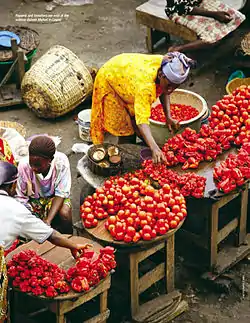
Agriculture is a sector of the Nigerian economy,[1] accounting for up to 35% of total employment in 2020.[2] According to the FAO,[3] agriculture remains the foundation of the Nigerian economy,[1] providing livelihoods for most Nigerians and generating millions of jobs.[4][5][6] Along with crude oil, Nigeria relies on the agricultural products it exports to generate most of its national revenue.[6] The agricultural sector in Nigeria comprises four sub-sectors: crop production, livestock, forestry, and fishing.
Nigeria has a total agricultural area of 70.8 million hectares,[7] of which 34 million hectares are arable land,[8] 6.5 million hectares are used for permanent crops, and 30.3 million hectares are meadows and pastures.
Maize, cassava, guinea corn, and yam are the major crops farmed in Nigeria, with 70% of the households engaged in crop farming. In the south, 7.3% of the households practice fishing, while 69.3% of the households own or raise livestock in northwest Nigeria.[9]
In the third quarter of 2019, before the COVID-19 pandemic, the sector grew by 14.88% year-on-year. Crop production remains the largest part of the sector. During the third quarter of 2019, the agriculture sector contributed 29.25% to the overall real GDP.[10] Between January and March 2021, agriculture contributed 22.35% of the total gross domestic product.[11][12][13][14][15]
The sector is undergoing transformation through commercialization at the small, medium, and large enterprise levels.[16] However, there are several factors in the Nigerian agricultural sector that may prevent its growth, including a land tenure system that limits access to land, the country's level of irrigation development, limited adoption of research findings and technologies, costs of farm inputs, the amount of access to credit allowed by the management of specialized institutions established for the development of the agricultural sector, the manners of fertilizer procurement and distribution, storage facility effectiveness, and the amount of access to markets.
More recently, changes in average temperatures, rainfall, climate extremes, and the growing infestation of pests and related diseases precipitated by climate change pose a challenge to the integrity of the country's agriculture system.[17] This is coupled with a dependence on rain-fed agriculture, which has made the sector vulnerable to seasonal conditions.[18]
These all contribute to agricultural productivity and post-harvest losses and waste in Nigeria.[3] Illiteracy is also one of the several factors preventing the progress and development of agriculture in Nigeria. Research has proven that most of the farmers in Nigeria have not acquired formal education.[19]
Dynamics
At the time of Nigeria's independence (1960), food exports made up more than 70% of the country's Gross National Product (GNP).[20] However, over the next 25 years, the situation reversed, with food items accounting for over 50% of imports. Despite having fertile land, food output in Nigeria declined, and per capita food production also decreased, leading to a more than sevenfold increase in grain imports.[21]
In the 1970s, the Nigerian government promoted the use of inorganic fertilizers to address the issue.[22] By 1990, out of Nigeria's total land area of about 91 million hectares, 82 million hectares were found to be suitable for farming, but only 42% of the cultivable area was farmed. The "bush fallow system," which involves land being left idle for a period of time to allow natural regeneration of soil fertility, was commonly used. Additionally, 18 million hectares were classified as permanent pasture, but had the potential to support crops, and most of the 20 million hectares covered by forests and woodlands were believed to have agricultural potential.[23]
Agricultural holdings are small and scattered, and farming is carried out with simple tools. Large-scale agriculture is not common. Agriculture contributed 32% to GDP in 2001.[24]
Animal agriculture
Livestock production is a part of Nigeria's agriculture system. In 2017, the country had about 80 million poultry birds, 76 million goats, 43.4 million sheep, 18.4 million cattle, 7.5 million pigs, and 1.4 million equids.[25] Livestock agriculture is about 5% of Nigeria's GDP, and 17% of its agriculture GDP.[26]
Meat demand has increased as economic development grows in Nigeria.[27] Animal grazing practices in Nigeria have changed due to population growth, urbanization, and changing agricultural practices.[28][29] Traditional nomadic herding has transitioned to sedentary and intensive grazing, leading to increased pressure on forested areas. Overgrazing, particularly in fragile ecosystems such as savannas and woodland areas, has caused a loss of vegetation, soil, and biodiversity.Production
In 2022, Nigeria produced:
- 59.6 million tons of cassava (the largest producer in the world). Nigeria accounts for up to 20% of the world's cassava production, about 34 per cent of Africa's, and about 46% of West Africa's;[3]
- 47.5 million tons of yam (the largest producer in the world);[30]
- 3.3 million tons of taro (the largest producer in the world);[31]
- 2.6 million tons of cowpea (the largest producer in the world);[32]
- 6.8 million tons of sorghum (the largest producer in the world);[33][34]
- 2 million tons of okra (2nd largest producer in the world, second only to India);[35]
- 2.8 million tons of peanut (3rd largest producer in the world, second only to China and India);
- 4 million tons of sweet potato (3rd largest producer in the world, second only to China and Malawi);
- 369 thousand tons of ginger (3rd largest producer in the world, losing only to India and China);
- 2.2 million tons of millet (4th largest producer in the world, second only to India, Niger, and Sudan);
- 7.8 million tons of palm oil (4th largest producer in the world, second only to Indonesia, Malaysia, and Thailand);
- 572 thousand tons of sesame seed (4th largest producer in the world, losing only to Sudan, Myanmar, and India);
- 332 thousand tons of cocoa (4th largest producer in the world, second only to Ivory Coast, Ghana, and Indonesia);
- 3 million tons of plantain (5th largest producer in the world);
- 833 thousand tons of papaya (6th largest producer in the world);
- 1.6 million tons of pineapple (7th largest producer in the world);
- 3.9 million tons of tomato (11th largest producer in the world);
- 6.8 million tons of rice (one of the largest producers of rice in Africa,[3] 14th largest producer in the world);
- 10.1 million tons of maize (14th largest producer in the world);
- 7.5 million tons of vegetables;
- 1.4 million tons of sugarcane;
- 1.3 million tons of potato;
- 949 thousand tons of mango (including mangosteen and guava);
- 938 thousand tons of onion;
- 758 thousand tons of soy;
- 747 thousand tons of green pepper;
- 585 thousand tons of egusi;
- 263 thousand tons of sheanut;
- 150 thousand tons of coconut.
In addition to smaller productions of other agricultural products,[36] Nigeria produced about 2.2 million metric tons of fish in 2008.[3]
Agricultural products
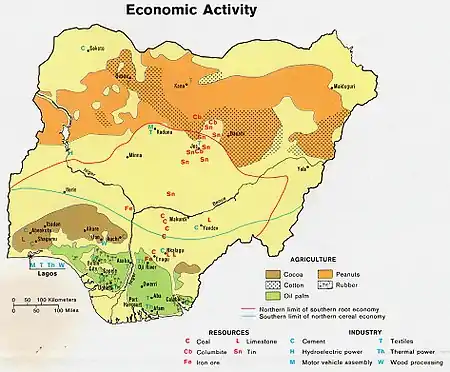
Crops grown in Nigeria include beans, rice, sesame, cashew nuts, cassava, cocoa beans, groundnuts, gum arabic, kolanut, cocoa, maize (corn), melon, millet, palm kernels, palm oil, plantains, rice, rubber, sorghum, soybeans, bananas, and yams.[37]
In the past, Nigeria was known for the export of groundnut and palm kernel oil. However, over the years, the rate of exportation of these products has decreased. A few years ago, local Nigerian companies started exporting groundnuts, cashew nuts, sesame seeds, moringa seeds, ginger, cocoa, and other crops.[38]
The country's agricultural products fall into two main groups: food crops produced for home consumption and cash crops sold for profits and exported abroad. Prior to the Nigerian civil war, the country was self-sufficient in food, but that decreased after 1973. Bread made from American wheat replaced domestic crops as the cheapest staple food.[24] Between 1980 and 2016, yam production increased from about 5 million tonnes to 44 million tonnes.[39]
| Tonnes produced in | 1980 | 2000 | 2016 |
|---|---|---|---|
| Maize | 612,000[40] | 4,107,000[40] | 764,678[41] |
| Millet | 2,824,000[42] | 5,814,000[42] | 1,468,668[41] |
| Guinea corn | 3,690,000[43] | 7,711,000[43] | 6,939,335[41] |
| Yam | 5,250,000[39] | 26,210,000[39] | 44,109,615[41] |
| Cassava | 11,500,000[44] | 32,697,000[44] | 57,134,478[41] |
| Rice, paddy | 1,090,000[45] | 3,298,000 | 6,070,813[41] |
| Melon seed | 94,000[46] | 345,000[46] | 569,398[41] |
| Cocoyam | 208,000[47] | 3,886,000[47] | 3,175,842[41] |
| Sesame seed | 15,000[48] | 72,000 | 460,988[47] |
Cocoa
Cocoa is the largest non-oil foreign exchange, but the dominance of smallholders and lack of farm labour due to urbanization hold back production. Some other factors holding back the production of cocoa include financing, a lack of a coordinating body, and low uptake of newer varieties of seedlings to rehabilitate old and cultivate new plantations. These factors are identified by multiple stakeholders.
The challenges have displaced the country from being the second-largest producer of cocoa beans to being the fourth, overtaken by Côte d'Ivoire, Ghana, and Indonesia. In 1969, Nigeria produced 145,000 tons of cocoa beans; however, it has the potential to produce over 300,000 per year. The Nigerian Government may give more incentives to cocoa farmers to increase productivity.[24]
Rubber
Rubber is the second-largest non-oil foreign exchange earner.[5][49] Rubber is grown across different states in Nigeria, including the Edo, Delta, Ondo, Ogun, Abia, Anambra, Akwa Ibom, Cross Rivers, Ebonyi, and Bayelsa states.[50]
Palm oil
The palm oil industry constitutes another sector of the Nigerian economy, providing food and raw materials for the food, cosmetics, pharmaceuticals, plastics, and bio-energy industries. In Nigeria, the institute with information about oil palm is the Nigeria Institute for Oil Palm Research. The formal mandate of the institute is to conduct research into the production and products of oil palm and other palms of economic relevance and transfer its research findings to farmers.[51]
Cash crop production
Cash crop production in Nigeria in 1980, 2000, and 2016
| Tonnes produced in[41] | 1980 | 2000 | 2016 |
|---|---|---|---|
| Oil palm fruit | 5,750,000 | 8,220,000 | 7,817,207 |
| Cocoa | 153,000 | 338,000 | 236,521 |
| Groundnut | 471,000 | 2,901,000 | 3,028,571 |
| Kola nut | 135,000 | 82,000 | 143,829 |
| Ginger | 200 | 98,000 | 522,964 |
Traditional native crops
Traditional native cereals such as fonio (Digitaria exilis and Digitaria iburua) are still grown in the Middle Belt of central Nigeria.[52]
Other traditional native crops in Nigeria are:[52]
Ministry of Agriculture
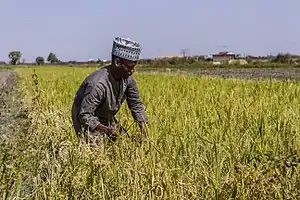
The government office responsible for agriculture development and transformation in Nigeria is currently the Federal Ministry of Agriculture and Rural Development. Primarily funded by Nigeria's federal government, the Ministry currently supervises almost fifty parastatals operating as either departments or agencies across the country. The Ministry has two major departments, namely the Technical and Service Departments:
- Technical Department: Manages agriculture (trees and crops), fisheries, livestock, land resources, fertilizer, food reserve and storage, and rural development.
- Service Department: Manages finance, human resources, procurement, PPAS (plan, policy, analysis and statistics), and co-operatives.
The ministry is headed by Audu Ogbeh, who was appointed by President Muhammad Buhari on 12 November 2015, succeeding Akinwumi Adesina, who was elected to head Africa Development Bank. Buhari also appointed Heineken Lokpobiri as the new Minister of State for Agriculture and Shehu Ahmad as the Permanent Secretary under the newly created Ministry of Agriculture and Rural Development.[53]
Policies
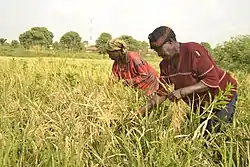
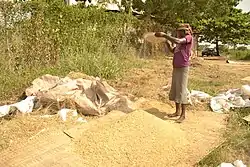
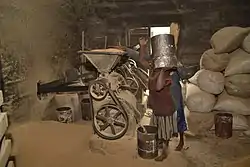
In 2011, President Jonathan's administration launched the Agricultural Transformation Agenda, which was overseen by the Federal Ministry of Agriculture and Rural Development. The primary goal of the agenda was to position agriculture as a profitable business, integrate the agricultural value chain, and establish agriculture as a primary driver of Nigeria's economic growth.[54] To achieve this agenda, the government implemented several measures:
- New fiscal incentives to encourage domestic import substitution
- Removal of restrictions on areas of investment and maximum equity ownership in investment by foreign investors
- Currency exchange controls – free transfer of capital, profits, and dividends
- Constitutional guarantees against nationalization/expropriation of investments
- Zero percent (0%) duty on agricultural machinery and equipment imports
- Pioneer Tax holiday for agricultural investments
- Duty waivers and other industry-related incentives, e.g., based on the use of local raw materials, export orientation
Recently, the Central Bank of Nigeria began the Anchors-Borrow program[55] to encourage the cultivation of certain crops, especially rice.
The Federal Government of Nigeria has also closed its land borders in order to curtail rice imports and encourage local production.[56][57]
Sustainable development Goals
The Sustainable Development Goals in the agriculture sector in Nigeria have had an impact on the export sector responsible for the consumption and production of agricultural products in Nigeria. The exportation sector's monthly earnings have improved in four years. In January 2016, agricultural exports raked in N4.1 billion, which then rose to N25 billion by January 2017. From April 2019 to March 2020, total agriculture exports hit N289 billion for Nigeria.
Agriculture exports for the first six months of 2020 were N204.45 billion, which indicates that productivity is increasing in the sector to enable export growth.[58]
The Sustainable Development Goals have also led to the emergence of policies that have had an impact on the agriculture sector. Some of them include the Nigerian “Agricultural Promotion Policy—2016–2020” which focuses on ensuring food security by reducing food imports. It manages institutional reforms and incentives for technological development at the local level. The Empowering Novel Agribusiness-Led Employment Program mobilizes finance for youth-led agribusiness development. Another policy is the Agricultural Credit Guarantee Scheme Act from 2016, which offers incentives to farmers and other professionals throughout the agricultural supply chain. Finally, the “Green Alternative: The Agriculture Promotion Policy” was launched in mid-2016. It was created to boost soybean and cowpea production, which were chosen for the policy's focus due to their nutritional value and export potential.[59]
See also
References
- 1 2 "10 Roles of Agriculture in Nigeria Economic Development". InfoGuideNigeria.com. 2020-12-06. Retrieved 2022-12-17.
- ↑ "Employment in agriculture (% of total employment) (modelled ILO estimate) - Nigeria". Work Bank Data. World Bank. 2020. Retrieved 24 November 2020.
- 1 2 3 4 5 "Nigeria at a glance | FAO in Nigeria | Food and Agriculture Organization of the United Nations". www.fao.org. Retrieved 2020-11-24.
- ↑ "Nigeria: agriculture sector share in employment". Statista. Retrieved 2022-12-17.
- 1 2 Adeite, Adedotun (2022-04-14). "Agriculture in Nigeria: 7 Interesting Facts & Statistics". Babban Gona. Retrieved 2022-12-16.
- 1 2 jlukmon (2022-11-18). "List 10 Importance of Agriculture in Nigeria". ABOUT NIGERIANS. Retrieved 2022-12-16.
- ↑ "Nigeria at a glance | FAO in Nigeria | Food and Agriculture Organization of the United Nations". www.fao.org. Retrieved 2022-12-17.
- ↑ cycles, This text provides general information Statista assumes no liability for the information given being complete or correct Due to varying update; Text, Statistics Can Display More up-to-Date Data Than Referenced in the. "Topic: Agriculture in Nigeria". Statista. Retrieved 2022-12-17.
- ↑ "Topic: Agriculture in Nigeria". Statista. Retrieved 2021-08-12.
- ↑ Nigerian Gross Domestic Product Report Q3 2019, National Bureau of Statistics. https://www.nigerianstat.gov.ng/pdfuploads/GDP_Report_Q3_2019.pdf
- ↑ "Nigeria at a glance | FAO in Nigeria | Food and Agriculture Organization of the United Nations". www.fao.org. Retrieved 2022-12-16.
- ↑ "Agriculture contributes 23% to GDP in 2022 – Minister". The Guardian Nigeria News - Nigeria and World News. 2022-09-15. Retrieved 2022-12-16.
- ↑ Isaac, Nkechi (2022-09-16). "Agriculture Contributed 23.3% To National GDP In Q2 – Abubakar". Science Nigeria. Retrieved 2022-12-16.
- ↑ "Agriculture contributes 23% to GDP in 2022 — Minister". NewsWireNGR. 2022-09-15. Retrieved 2022-12-16.
- ↑ Ukpe, William (2022-08-26). "GDP: Nigeria's Agriculture sector grows by 1.20% in Q2 2022". Nairametrics. Retrieved 2022-12-16.
- ↑ Olomola Ade S. (2007) “Strategies for Managing the Opportunities and Challenges of the Current Agricultural Commodity Booms in SSA” in Seminar Papers on Managing Commodity Booms in Sub-Saharan (:Africa: A Publication of the AERC Senior Policy Seminar IX. African Economic Research Consortium (AERC), Nairobi, Kenya
- ↑ Kurukulasuriya, Pradeep (2013). "Climate Change and Agriculture: A Review of Impacts and Adaptations". Climate Change Series 91 Environment Department Papers, World Bank, Washington, D.C.
- ↑ Olayide, Olawale Emmanuel; Tetteh, Isaac Kow; Popoola, Labode (December 2016). "Differential impacts of rainfall and irrigation on agricultural production in Nigeria: Any lessons for climate-smart agriculture?". Agricultural Water Management. 178: 30–36. doi:10.1016/j.agwat.2016.08.034. ISSN 0378-3774.
- ↑ "6 Agriculture Problems in Nigeria—and Solutions". agricdemy.com. Retrieved 2022-12-16.
- ↑ "Economy". www.nigeriahc.org.uk. Retrieved 2022-02-28.
- ↑ Obasanjo, Olusegun (1988). Africa Embattled. Ibadan: Fountain Publications. p. 79. ISBN 9782679364.
- ↑ Pasquini, MW; Alexander, MJ (2005). "Soil fertility management strategies on the Jos Plateau: the need for integrating 'Empirical' and 'Scientific' knowledge in agricultural development". Geographical Journal. 171 (2): 112–124. doi:10.1111/j.1475-4959.2005.00154.x.
- ↑ Countries studies, Nigeria
- 1 2 3 Nigeria agriculture
- ↑ OHDI (2020-10-07). "Livestock Production in Nigeria - A thriving Industry". One Health and Development Initiative (OHDI). Retrieved 2023-08-24.
- ↑ "Nigeria". www.ilri.org. 2023-08-07. Retrieved 2023-08-24.
- ↑ "Demand for farm animal products in Nigeria: An opportunity for Sahel Countries? - Inter-réseaux". www.inter-reseaux.org/ (in French). Retrieved 2023-08-24.
- ↑ Amadou, Hamadoun; Dossa, Luc Hippolyte; Lompo, Désiré Jean-Pascal; Abdulkadir, Aisha; Schlecht, Eva (2012-03-20). "A comparison between urban livestock production strategies in Burkina Faso, Mali and Nigeria in West Africa". Tropical Animal Health and Production. 44 (7): 1631–1642. doi:10.1007/s11250-012-0118-0. ISSN 0049-4747. PMC 3433665. PMID 22430479.
- ↑ Aribido, S O; Bolorunduro, B I (2004-12-13). "Implications of Ecological Changes on Sustainable Livestock Production in the Lake Chad Basin of Nigeria". Tropical Journal of Animal Science. 6 (2). doi:10.4314/tjas.v6i2.31080. ISSN 1119-4308.
- ↑ omotolani (2022-03-28). "Nigeria is the highest producer of yam, thanks to these states". Pulse Nigeria. Retrieved 2022-12-16.
- ↑ "Top Taro Producing Countries In The World". WorldAtlas. 2017-11-28. Retrieved 2022-12-16.
- ↑ "You are being redirected..." www.iita.org. Retrieved 2022-12-16.
- ↑ "Sorghum Production by Country | World Agricultural Production 2022/2023". www.worldagriculturalproduction.com. Retrieved 2022-12-16.
- ↑ "Sorghum Production by Country in 1000 MT - Country Rankings". www.indexmundi.com. Retrieved 2022-12-16.
- ↑ "World Okra Production by Country". AtlasBig. 1970-01-01. Retrieved 2022-12-16.
- ↑ Nigeria production in 2018, by FAO
- ↑ Adesoji, Bamidele Samuel (2019-08-17). "Top 10 Agricultural Products Export from Nigeria". Nairametrics. Retrieved 2021-03-21.
- ↑ Adesoji, Bamidele Samuel (2019-09-25). "Nigeria's top 10 agricultural exports hit N152 billion in half-year 2019". Nairametrics. Retrieved 2021-03-21.
- 1 2 3 Verter, Nahanga (2015-05-01). "An Analysis of Yam Production in Nigeria". Acta Universitatis Agriculturae et Silviculturae Mendelianae Brunensis. 63 (2): 659–665. doi:10.11118/actaun201563020659.
- 1 2 "Nigeria Maize production, 1961-2017 - knoema.com". Knoema. Retrieved 2018-07-19.
- 1 2 3 4 5 6 7 8 9 "FAOSTAT". www.fao.org. Retrieved 2018-07-19.
- 1 2 "Quandl". www.quandl.com. Retrieved 2018-07-19.
- 1 2 "factfish Sorghum, production quantity for Nigeria". www.factfish.com. Retrieved 2018-07-19.
- 1 2 Philip; Taylor, D; Sanni, L; Okechukwu, R; Ezedinma, Chuma; Akoroda, M; Lemchi, J; Ilona, Paul; Ogbe, F (2005-03-01). The Nigerian Cassava Industry Statistical Handbook. ISBN 978-978-131-268-7.
- ↑ "Nigeria Rice, paddy production, 1961-2017 - knoema.com". Knoema. Retrieved 2018-07-19.
- 1 2 "factfish for Nigeria". www.factfish.com. Archived from the original on 2018-07-19. Retrieved 2018-07-19.
- 1 2 3 "factfish Taro, production quantity for Nigeria". www.factfish.com. Retrieved 2018-07-19.
- ↑ Adole, Sharon (2012). Economic Analysis of Sesame Production Among Small-Holder Farmers in Benue State, Nigeria (Thesis). Ahmadu Bello University. Archived from the original (PDF) on 2019-02-14. Retrieved 2018-07-19.
- ↑ "The Performance of Rubber Exports in Nigeria" (PDF).
- ↑ "International Rubber Study Group - Nigeria". www.rubberstudy.org. Retrieved 2022-02-28.
- ↑ "Oil Palm". www.nifor.gov.ng. Retrieved 12 May 2018.
- 1 2 Blench, Roger (2006). Archaeology, language, and the African past. Altamira Press. ISBN 9780759104655.
- ↑ "Food Import Bill". Archived from the original on 2015-12-19. Retrieved 2015-11-11.
- ↑ Adesina, A. (2012, November 1). Agricultural Transformation Agenda: Repositioning agriculture to drive Nigeria’s economy. Retrieved from http://www.emrc.be/documents/document/20121205120841-agri2012-special_session-tony_bello-min_agric_nigeria.pdf Archived 2016-03-04 at the Wayback Machine
- ↑ "CBN and the Anchor Borrowers' ProgrammeE". ThisDayLive. 2020-03-01. Retrieved 2020-05-29.
- ↑ "Nigeria's border crisis fuelled by rice". BBC News. 2019-10-31. Retrieved 2020-11-26.
- ↑ "You are being redirected..." businessday.ng. 24 September 2020. Retrieved 2020-11-26.
- ↑ Ukpe, William (2020-10-01). "Nigeria @ 60: Agriculture and the way forward". Nairametrics. Retrieved 2021-03-27.
- ↑ Gil, Juliana & Reidsma, P. & Giller, Ken & Todman, Lindsay & Whitmore, Andrew & Ittersum, Martin. (2018). Sustainable development goal 2: Improved targets and indicators for agriculture and food security. Ambio. 48. 10.1007/s13280-018-1101-4.
External links
- Agriculture & Animals Motherland Nigeria
- AgroNigeria: Nigeria's Agricultural Mouthpiece
- West African Agricultural Market Observer/Observatoire du Marché Agricole (RESIMAO)
- Major Farming Problems in Nigeria-Crop Farmers and Livestock Rearers
